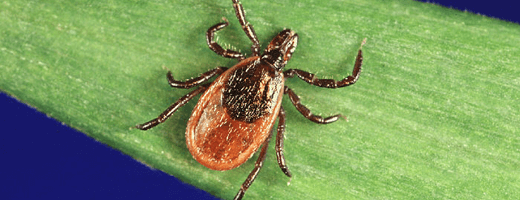 May is Lyme Disease Awareness Month in New Brunswick and we’re reminding folks that, while the summer months do bring the risk of being bit by a tick, minimizing the risk of contracting Lyme doesn’t mean you have sacrifice your connection with nature.
May is Lyme Disease Awareness Month in New Brunswick and we’re reminding folks that, while the summer months do bring the risk of being bit by a tick, minimizing the risk of contracting Lyme doesn’t mean you have sacrifice your connection with nature.
Instead of avoiding your walking trail, use Lyme Disease Awareness Month to refresh your memory and spread the word on how to protect yourself against these tiny, potentially disease-carrying insects.
Lyme disease is caused by a dangerous mixture of bacteria found in Black-legged ticks, which comprise nearly a tenth of the total population of ticks in New Brunswick. Black-legged ticks can be found anywhere in the province, but are commonly found in higher numbers in southern New Brunswick. They prefer grassy and forested areas, and seek hosts by climbing on vegetation such as tall grasses or shrubs and waiting for a host to rub against them. When this occurs, they climb onto the host’s body and eventually attempt to attach and feed.
Here are four ways you can minimize your exposure to ticks while out and about in nature this summer:
- Wear long-sleeve shirts, pants, long socks, and long boots.
- Use duct tape to seal holes between clothing, especially in grassy, forested areas.
- After each outing, give yourself a thorough check for ticks (as well as your gear, pets and friends or family with you). Pay particular attention to the areas behind your knees, on the inside of your elbows, and behind your ears.
- Use insect repellent (but make sure it won’t hurt our pollinator friends — learn more about your options here).

Certain communities in N.B. are at a greater risk of contracting Lyme disease due to higher tick populations in those regions. Please pay special attention if you’re travelling in grassy or forested areas near:
- Grand Manan
- Grand Bay-Westfield, Saint John, Rothesay, and Quispamsis
- St. Stephen, Saint Andrews and St. George
The long-term health effects caused by Lyme disease can be dangerous, so it’s important to take precautions to minimize your exposure to ticks.
If you suspect a bite, look for the early symptoms of Lyme, including a rash resembling a bull’s eye target around the bite, and flu-like symptoms. See a health-care practitioner if these symptoms are present within 30 days of removing the tick. If left untreated, the infection can spread to joints, the heart, and the nervous system, and can cause serious symptoms such as memory loss and loss of motor function.
It’s serious business — but if we all take the proper precautions, we can stay safe and enjoy the beautiful outdoors of N.B. this spring, summer and fall.
For more information,
-30-
For additional resources on Lyme disease, see:
- Lyme disease: Causes, Symptoms, Risks, Treatments and Prevention
- Read the Province of New Brunswick’s news release on Lyme Disease Awareness Month
- Government of Canada’s Role in Lyme Disease
- Conference to develop a federal framework on Lyme disease
- Consultation on the draft Federal Framework on Lyme disease
